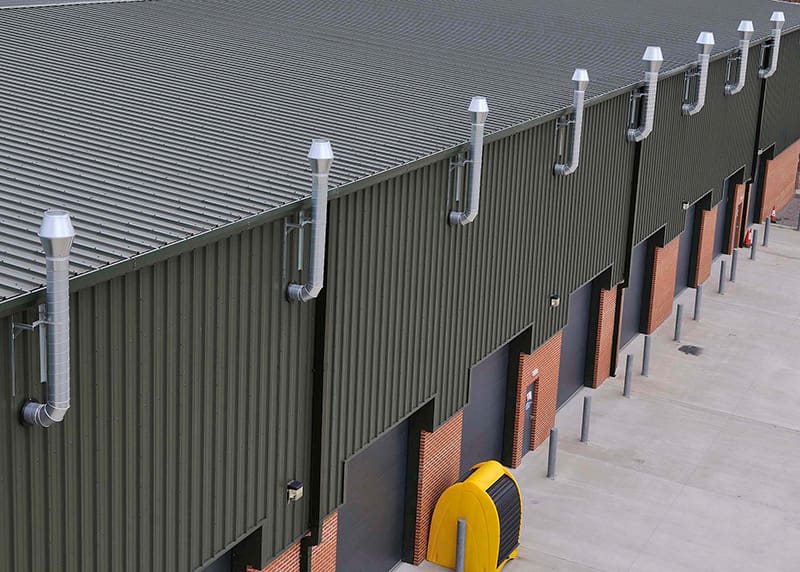
Not all cowls are made equal – and some are plain dangerous. There’s one exhaust solution though, which literally and metaphorically rises above the rest, a vertical extraction cowl from Fumex.
If you have an existing extraction system in place, you’ll be familiar with their main constituent parts.
In the main, they’ll consist of an extraction nozzle or port, at the source of the substance to be extracted, followed by a filter system.
Connecting these elements is of course ducting and tube work, and you won’t get far without a motorised fan unit to provide the airflow and suction required.
Finally, once the substances have been extracted and filtered, the air is exhausted to the atmosphere outside the working environment.
It’s not enough to simply have an open pipe, like a domestic chimney. The exhaust needs a specialised attachment to ensure effective expulsion of any remaining pollutants and provide required weather protection too.
This attachment is what we refer to as a cowl and varies according to the installation environment, attached equipment and substances being removed.
While there are many options available, our preferred unit is a vertical extraction cowl.
We’ll explain why later.
You’d be forgiven for thinking you could simply allow the gases, air and other extracted substances to vent outside, and leave it at that.
After all, they’re filtered, and no longer in your workspace.
Unfortunately, the reality is rather more complex. There are three principal reasons that you need a proper extraction cowl: increased protection, greater efficiency, and improved safety.
Unfortunately, the business end of your extraction system is exposed and out in the open.
Cowls are designed for many purposes. Crucially they shield from rain and moisture, preventing damage to the extraction system and ingress of water into the building.
A vertical extraction cowl will have a mesh screen or baffle integrated into their design. This helps prevent the entry of leaves, debris, birds and insects, helping to maintain airflow and prevent blockages.
As mentioned above, a proprietary extraction cowl will ensure proper airflow and optimise airflow direction.
Some, such as our vertical extraction cowl, also feature design elements that encourage airflow, reducing backdraft and maintaining full extraction of pollutants and preventing re-entry into the building.
Maintaining full efficiency is crucial to prevent premature degradation of parts such as fans and motors which would otherwise have to work harder to maintain the required airflow.
Reduced extraction also impacts your workplace productivity, as operators and equipment will have to fight against the effect of having increased pollutant levels, or simply more debris such as swarf or dust around the work area.
Of course, your workplace will be safer without the airborne pollutants.
Fitting an extraction cowl however will also reduce the likelihood of fires within your ductwork by preventing build-up of flammable fuels such as grease or dust.
There are several types of cowl available on the market.
Exhaust cowls that face downward (back toward the building) include swan-neck and “coolie” cowls.
These provide weather protection however as they direct potential pollutants toward the building and work area, they are now illegal.
Designed to maintain airflow while preventing backdrafts, these cowls have flaps over their open end which rise with airflow.
They can fall back down when airflow is reduced or when the wind blows against them, preventing flow of air back along the duct.
These cowls use an integrated fan to actively draw air out, providing improved performance, especially in challenging conditions and environments.
These are often installed where roof installation isn’t feasible.
These are effective in reducing wind resistance as they incorporate a spiral design that helps improve airflow efficiency.
Where targeted extraction is required, these parabola shaped cowls can be useful as they effectively direct airflow.
As the name suggests, these have adjustable louvres, which allow for controlled airflow which can be oriented to direct air according to wind direction.
These encourage pollutants away from the building and work area in an upward jet (hence the name).
Similar to the jet cowl, however with increased airflow, reducing back pressure against the fan, improving efficiency and reducing motor wear.

The type of cowl you opt for, or that is specified by your system designer, ultimately depends on the type of extraction system in use or required, the building it is installed within, and the exterior environment.
This being said, in most cases, we recommend a Vertical Extraction Cowl made by us at Fumex.
Here’s why:
Whether you’re installing a new extraction system from scratch, repairing degraded existing parts, or just need an upgrade, we’ll have a roof cowl that exceeds your requirements.
Overall, we recommend our vertical extraction cowl.
Its versatility means it’s a great addition in the majority of situations. It will not only prolong the lifespan of your extraction system, but also improve extraction performance.
To see how we can upgrade your extraction system with a vertical extraction cowl or include one in your upcoming extraction project, get in touch with our in-house experts today.